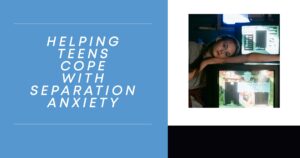Adolescence is a period of immense change — physically, emotionally, and socially. As teenagers transition from childhood to adulthood, mood swings, shifting interests, and boundary-testing behaviors are often part of the journey. But for parents and caregivers, it’s crucial to recognize when these changes cross the line from normal teenage development into signs of deeper struggles.
Identifying red flags in teenage behavior early can make all the difference. From subtle shifts in mood and social habits to more concerning signs like isolation, defiance, or substance abuse, these behaviors often point to underlying mental health challenges that shouldn’t be ignored. Parents can step in before issues escalate by staying observant and proactive, offering the support, structure, and professional help their teen may need.
Recognizing Red Flags in Teenage Behavior
Teenagers go through many changes – emotionally, physically, and socially – as they navigate adulthood. While some moodiness, independence-seeking, and privacy are standard, specific behavior patterns can signal that something deeper is going on. Recognizing these red flags in teenage behavior early is crucial because they often point to underlying mental health struggles, emotional distress, or environmental challenges that need attention.
Watch for consistent changes like increased mood swings, withdrawal from family and friends, sudden drops in grades, defiance, secrecy, or noticeable shifts in appearance and hygiene. These behaviors often don’t occur in isolation; when several appear together or intensify over time, it’s a strong sign that your teen may struggle. Early detection allows parents and caregivers to intervene before issues escalate, offering support, understanding, and professional help when needed.

Common Signs of Troubling Behavior in Teens
It’s normal for teenagers to experience ups and downs, but when certain behaviors become persistent, intense, or disruptive, they may signal a deeper problem. Some of the most common red flags in teenage behavior include:
- Substance abuse: Experimenting with alcohol or drugs can quickly become a coping mechanism for stress or emotional pain.
- Declining grades: Sudden drops in academic performance often reflect underlying emotional or cognitive struggles.
- Defiance and rule-breaking: Frequent arguments, disrespect, or disregard for rules may indicate frustration, anger, or unmet emotional needs.
- Secretive behavior: Hiding information, lying about whereabouts, or becoming overly private could point to risky activities or mental health concerns.
- Changes in appearance: Rapid weight changes, poor hygiene, or drastic fashion shifts can be signs of depression, anxiety, or low self-esteem.
Emotional and Mood-Related Red Flags
Teenagers are known for their emotional volatility, but some mood changes go beyond typical adolescent behavior. Watch for:
- Intense mood swings: Frequent shifts from euphoria to anger or sadness may point to mood disorders or emotional dysregulation.
- Loss of interest: Withdrawing from hobbies or activities once enjoyed is a common early sign of depression.
- Hopelessness or worthlessness: Low self-esteem or self-hatred expressions should always be taken seriously.
- Excessive irritability: Constant anger or frustration, especially when out of proportion to the situation, could signal underlying mental health struggles.
- Self-harm or suicidal thoughts: Any sign of self-injury or talk of hopelessness warrants immediate professional help.
Hillside Horizon
Teenage Red Flags for Social and Academic Indicators
Social interactions and academic performance are two of the most telling areas where behavioral changes occur during adolescence. While occasional struggles are normal, consistent patterns like withdrawing from friends, skipping social activities, losing interest in school, or a sudden drop in grades may signal deeper emotional, mental health, or behavioral challenges. Paying attention to these shifts helps parents and caregivers intervene early and provide the proper support before problems escalate.
Here’s a quick guide to common social and academic red flags:
| Indicator | What to Watch For | What It Might Indicate |
| Social Withdrawal | Avoiding friends, skipping social events, or spending excessive time alone. | Depression, anxiety, bullying, or low self-esteem. |
| Isolation | Preferring solitude and resisting communication with family or peers. | Emotional distress, trauma, or social anxiety. |
| Declining Grades | Sudden drop in academic performance or lack of motivation. | Attention difficulties, depression, or disengagement. |
| Frequent Absences | Skipping classes or avoiding school altogether. | Bullying, anxiety, or fear of failure. |
| Loss of Interest | No longer participating in activities or hobbies once enjoyed. | Early signs of depression or burnout. |
Social Withdrawal and Isolation
While teens naturally seek independence, isolation is one of the most concerning red flags. If your teen is spending increasing amounts of time alone, avoiding social interactions, or losing interest in friendships, it could be a sign of depression, anxiety, bullying, or other emotional issues.
It’s important to differentiate between healthy alone time and problematic withdrawal. Occasional solitude is normal, but persistent avoidance of social situations — especially if paired with mood changes or declining self-esteem — often indicates deeper struggles.
Academic Performance and School-Related Concerns
A teenager’s school performance can provide valuable insight into their mental and emotional well-being. Declining grades, frequent absences, or loss of motivation often stem from more than just laziness. They might be signs of:
- Learning difficulties: Undiagnosed learning disorders can lead to frustration and withdrawal.
- Emotional distress: Anxiety, depression, or trauma can impair focus and motivation.
- Bullying or social challenges: A hostile school environment can cause avoidance and poor performance.
Hillside Horizon
Teenage Risk Behaviors and Technology Influence
Today’s teens are growing up in a digital-first world — and while technology offers many benefits, it also introduces new risks. Social media, in particular, can amplify feelings of inadequacy, fuel anxiety, and expose teens to harmful influences.
Red flags to watch for include:
- Secretive online behavior: Hiding devices, deleting browsing history, or using secondary accounts.
- Drastic mood changes after screen time: Increased irritability or sadness after using social media.
- Online peer pressure: Engaging in risky challenges, sexting, or inappropriate communication.
- Excessive screen time: Replacing real-world interactions with digital ones can deepen isolation and hinder emotional growth.
Supporting Teens at Hillside Horizon for Teens
Parenting a teenager is challenging, but navigating concerning behaviors doesn’t have to be a journey you face alone. At Hillside Horizon for Teens, we understand the complex emotional, social, and psychological pressures adolescents face, and we’re here to help.
Our specialized programs combine evidence-based therapy, family counseling, and individualized support to address the root causes of behavioral changes. Whether your teen is struggling with substance abuse, isolation, defiance, mood swings, or academic decline, our team provides the tools and guidance they need to heal, grow, and thrive.
Contact Hillside Horizon for Teens today to learn how we can help your family navigate the challenges of adolescence.

Hillside Horizon
FAQs
How can parents identify signs of substance abuse in teenagers, and what are the common indicators to watch for?
Look for physical signs such as bloodshot eyes, sudden weight changes, or unexplained smells, along with behavioral shifts like secretiveness, withdrawal, and changes in friend groups.
What mood swings and emotional changes should raise concerns about a teenager’s mental health?
Frequent mood swings, intense anger, persistent sadness, or feelings of hopelessness — especially when prolonged — may signal depression, anxiety, or other mental health concerns.
How does social isolation in teenagers differ from normal alone time, and when should parents be worried?
Occasional solitude is normal, but withdrawal from friends, avoidance of social activities, and loss of interest in relationships are warning signs of potential emotional struggles.
What are some potential reasons for declining grades in teens, and how can parents address academic performance issues?
Mental health challenges, learning difficulties, bullying, or lack of motivation can all cause declining grades. Early communication with teachers and professional support can help address these issues.
How should parents approach secretive or defiant behavior in teenagers, and what underlying issues might be causing these changes?
Approach your teen with empathy and open communication rather than punishment. Such behaviors may be coping mechanisms for stress, trauma, peer pressure, or emotional distress.





